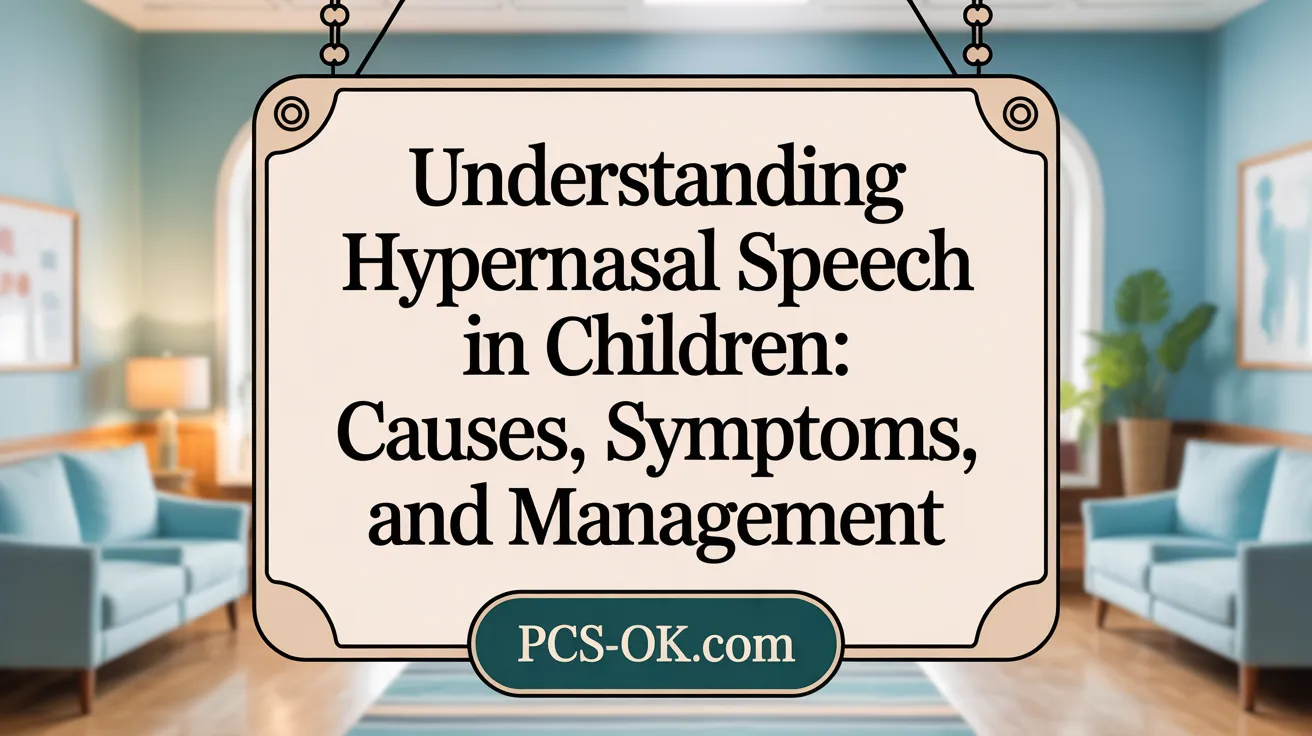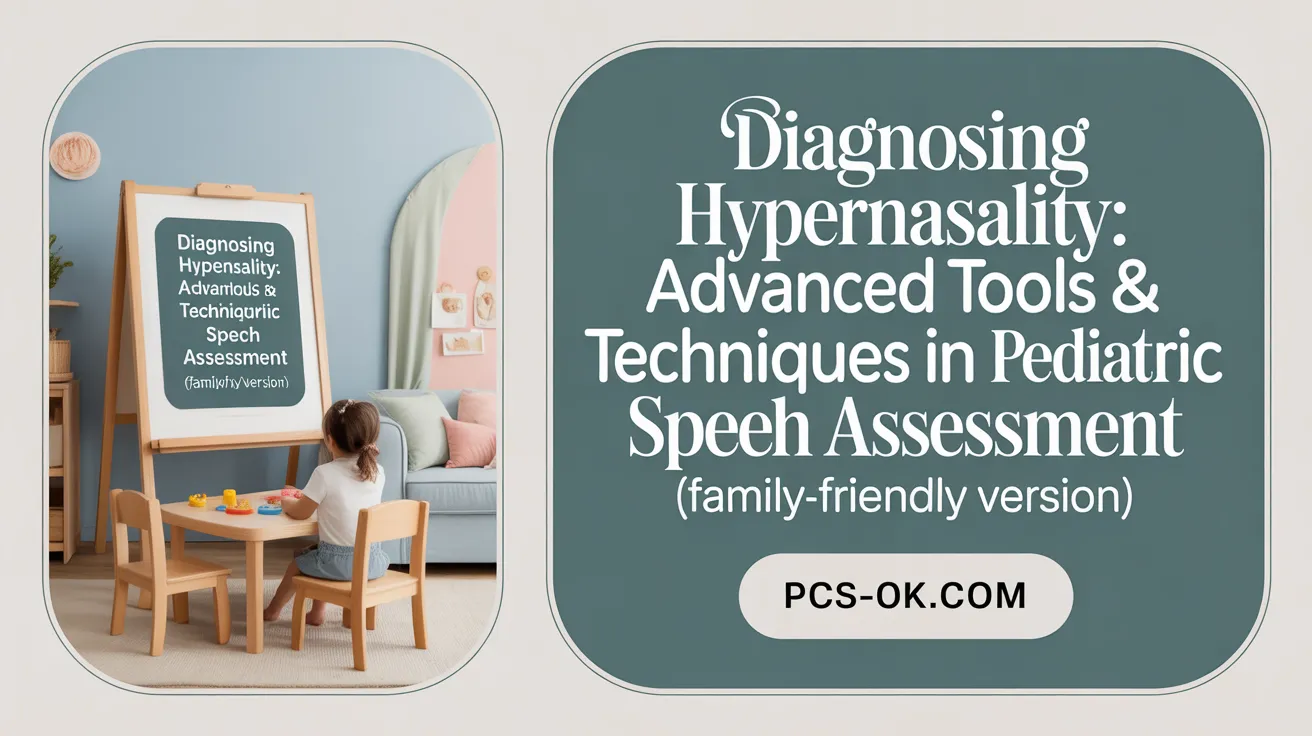Hypernasal Speech in Kids: Causes and Treatment Options
What Parents and Caregivers Need to Know About Hypernasal Speech
Hypernasal speech in children is a common but often misunderstood speech disorder that affects clarity and communication. It occurs when excessive air escapes through the nose during speech due to improper closure of the velopharyngeal valve. This article explores the causes, diagnosis, and treatment options for hypernasality, providing valuable insights for parents, caregivers, and professionals dedicated to helping children speak more clearly and confidently.
What Is Hypernasal Speech in Children? Causes and Symptoms Explained

What is hypernasal speech in children and what are its common causes and symptoms?
Hypernasal speech in children is characterized by a nasal quality to their voice, caused by too much air and sound passing through the nose during speech. This condition occurs when the soft palate, also called the velum, does not close properly against the back of the throat during speaking, a phenomenon known as velopharyngeal dysfunction.
The main role of the velopharyngeal mechanism is to separate the oral and nasal cavities during speech, ensuring sounds are produced clearly. When this closure is incomplete or ineffective, excess air escapes through the nose, creating a hypernasal voice.
Common causes include structural abnormalities such as cleft palate—an opening in the roof of the mouth—or submucous cleft, which is a hidden cleft covered by the lining of the palate. A short or dysfunctional soft palate can also impair closure.
In addition, neurological conditions like cerebral palsy can affect the muscles controlling the palate, resulting in velopharyngeal incompetence. These issues may be present from birth or develop due to injury or illness.
Children with hypernasal speech often display several noticeable symptoms. These include a nasal-sounding voice, nasal emissions during speech—where bursts of air escape through the nose—and sometimes nasal regurgitation of food or liquids. Articulation difficulties may also appear, particularly with consonants that require oral pressure, making speech less clear and intelligible.
Timely identification and management are important for improving speech quality and preventing associated communication challenges.
Diagnosing Resonance Disorders: How Specialists Identify Hypernasality in Children

How are resonance disorders like hypernasality diagnosed in pediatric patients?
Diagnosing hypernasality in children involves a thorough process carried out by speech-language pathologists (SLPs). These specialists perform perceptual speech analyses, listening carefully to identify nasal quality in speech during natural conversation and structured speech tasks. They might ask the child to repeat specific phrases or sounds to see if the speech sounds excessively nasal.
In addition to auditory assessment, physical examinations of the mouth, soft palate, and throat are performed to observe the movement of the velopharyngeal structures. This helps in understanding if structural abnormalities or dysfunctions are contributing to hypernasality.
Instrumentation adds objectivity to diagnosis. Nasometry, a non-invasive test, measures the amount of acoustic energy coming through the nose and mouth during speech, giving quantifiable data on nasal resonance. To gain detailed visual information about the velopharyngeal mechanism, procedures like nasal endoscopy or videofluoroscopy are used. These imaging techniques allow specialists to observe the movement and closure of the soft palate and lateral pharyngeal walls in real time.
A comprehensive, multidisciplinary approach often proves most effective. ENT doctors, surgeons, and other health professionals collaborate with speech therapists to interpret findings accurately. This team-based strategy ensures that the diagnosis is precise, whether the hypernasality stems from structural issues like a cleft palate or functional problems such as muscle weakness.
Ultimately, identifying the specific cause—structural or functional—guides targeted treatment, which may include speech therapy, surgical intervention, or a combination of both. Early and accurate diagnosis is vital to improve speech development and communication skills in affected children.
| Diagnostic Method | Purpose | Additional Details |
|---|---|---|
| Perceptual speech analysis | Detects abnormal nasal resonance during speech | Usually performed by trained SLPs |
| Oral exams | Observe articulatory movements and palate function | Physical inspection and palpation |
| Nasometry | Measures nasal acoustic energy during speech | Provides quantitative data on resonance |
| Nasal endoscopy | Visualizes velopharyngeal closure mechanisms | Minimally invasive, performed in office |
| Videofluoroscopy | Dynamic X-ray imaging of soft palate movement | Offers real-time visualization |
Understanding and utilizing these diagnostic tools allows clinicians to tailor effective, individualized treatment plans for children facing hypernasality.
Understanding Velopharyngeal Dysfunction and Its Impact on Speech

What is velopharyngeal dysfunction and how does it relate to hypernasality in children?
Velopharyngeal dysfunction (VPD) involves problems with the soft palate and the surrounding muscles that control speech and swallowing. Normally, during speech, the velopharyngeal valve closes completely to separate the nasal cavity from the mouth. When this closure is incomplete or ineffective, excessive air and sound escape through the nose.
This leads to hypernasality, a condition where speech sounds overly nasal. Children with VPD often speak with a nasal tone, and their speech clarity can be reduced. The root causes of VPD are varied, including structural abnormalities like cleft palate or submucous cleft palate, neurological issues such as nerve damage that impair muscle movement, or functional problems like improper speech patterns or mislearning.
The inability of the soft palate to close properly causes nasal emission of air and sounds during speech, making words sound muffled or nasal. Accurate diagnosis involves speech evaluation and imaging tests to assess velopharyngeal closure. Effective treatment depends on the underlying cause, often combining surgical correction with speech therapy to improve speech quality and reduce hypernasality.
Understanding the different forms of VPD and their specific causes is crucial for selecting the appropriate intervention and helping children develop clearer, more natural speech patterns.
Treatment Options: Speech Therapy Techniques and Surgical Interventions for Hypernasality

What treatment options and speech therapy techniques are effective for managing hypernasal speech in children?
Managing hypernasal speech effectively often requires a combination of approaches. Speech therapy forms the foundation of treatment, especially in cases where the problem is functional or related to learned speech patterns. Speech-language pathologists employ various techniques aimed at improving velopharyngeal function and speech quality.
One common goal is to help children gain better control over airflow and resonance during speaking. Techniques include:
- Altering tongue placement to reduce nasal airflow.
- Using visual aids like mirrors for biofeedback, allowing children to see their tongue and mouth position.
- Distinguishing between oral and nasal sounds to improve articulation.
- Controlling speech volume and pitch to manage nasal resonance.
- Auditory feedback exercises that help children monitor and adjust their speech.
These exercises enhance the child’s ability to produce clearer speech and reduce hypernasality. For children with structural issues such as velopharyngeal insufficiency, speech therapy alone might not suffice. In such cases, surgical procedures or prosthetic devices are often necessary.
Surgical options like palatoplasty aim to repair or reconstruct the palate, reducing nasal air escape. Prosthetic devices, such as palatal lifts or speech bulbs, can also assist in achieving better velopharyngeal closure.
Early assessment and intervention are crucial. Engaging in ongoing multidisciplinary care—including surgeons, speech therapists, and audiologists—ensures the best chance for improving speech outcomes and preventing long-term communication difficulties.
Overview of Speech Resonance Disorders in Children and Their Management

What are speech resonance disorders, and how are they managed in young patients?
Speech resonance disorders involve abnormal sound qualities during speech, mainly due to how air and vibrations move through the mouth, nose, and throat. Often, these disorders include hypernasality, hyponasality, cul-de-sac resonance, and sometimes a mixture of these issues.
Each type has different causes and symptoms. Hypernasality occurs when too much nasal sound escapes during speech, often because of structural problems like cleft palate or velopharyngeal dysfunction (VPD). Symptoms include a nasal, muffled, or muffled voice, and difficulty with pronouncing certain sounds.
Hyponasality, on the other hand, results from blockages or obstructions such as enlarged tonsils, allergies, or a deviated septum, leading to a congested or
Supporting Children with Hypernasal Speech for Clearer Communication
Hypernasal speech in children is a complex condition rooted primarily in velopharyngeal dysfunction that can significantly impact communication and social interaction. Understanding its causes, accurate diagnosis, and the range of effective treatment options—from targeted speech therapy to surgical corrections—empowers caregivers and professionals to support affected children effectively. Early detection and coordinated multidisciplinary care are crucial to improving speech outcomes and helping children develop clearer, more confident voices for their future.
References
- Hypernasal Speech | Pediatric Speech Disorders
- Speech Therapy Treatments For Hypernasality
- Resonance Disorders
- Velopharyngeal Dysfunction | Types & Treatment
- Hypernasality | Speech and Health Library
- Snorty Talkers: Could Your Child Have Hypernasality?
- Velopharyngeal Dysfunction (VPD)
- Speech Therapy Treatments For Hypernasality
